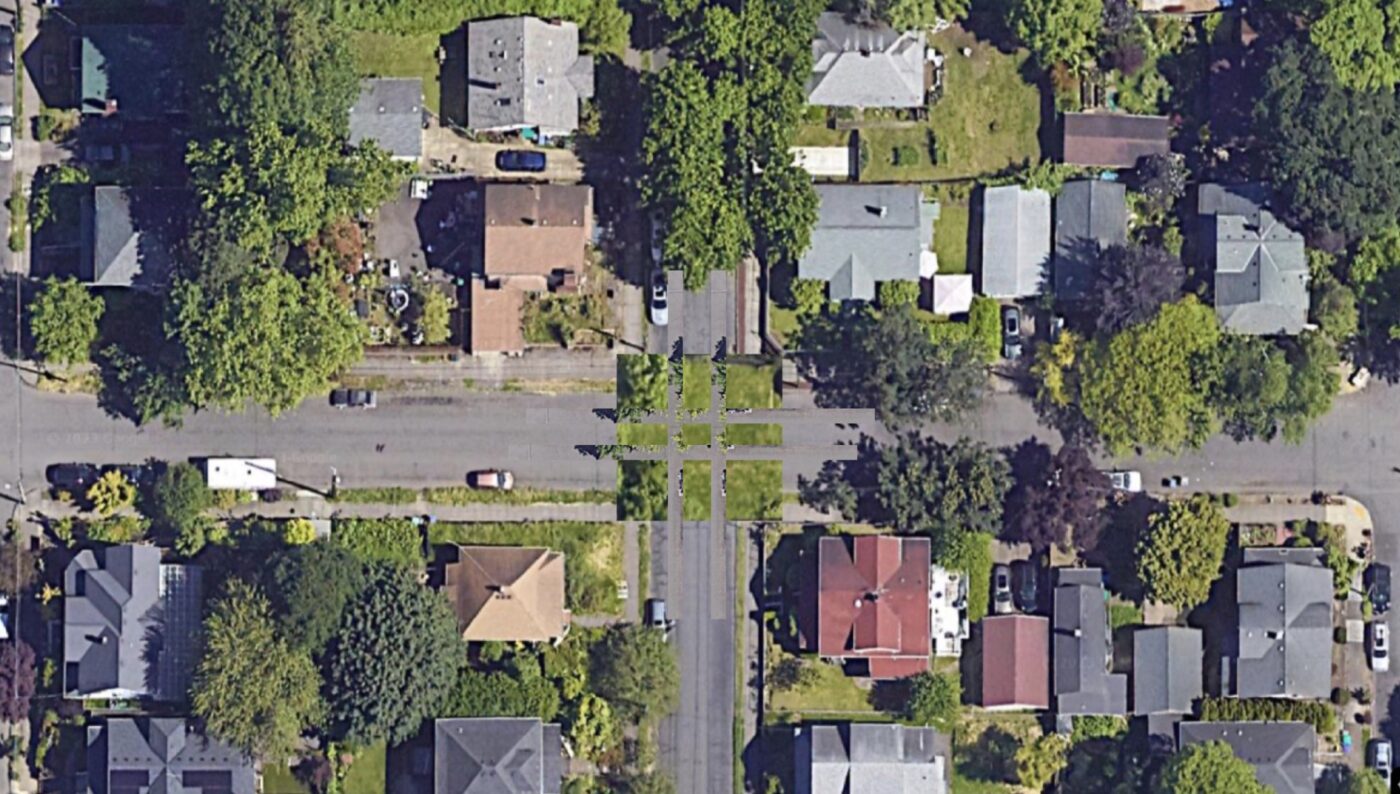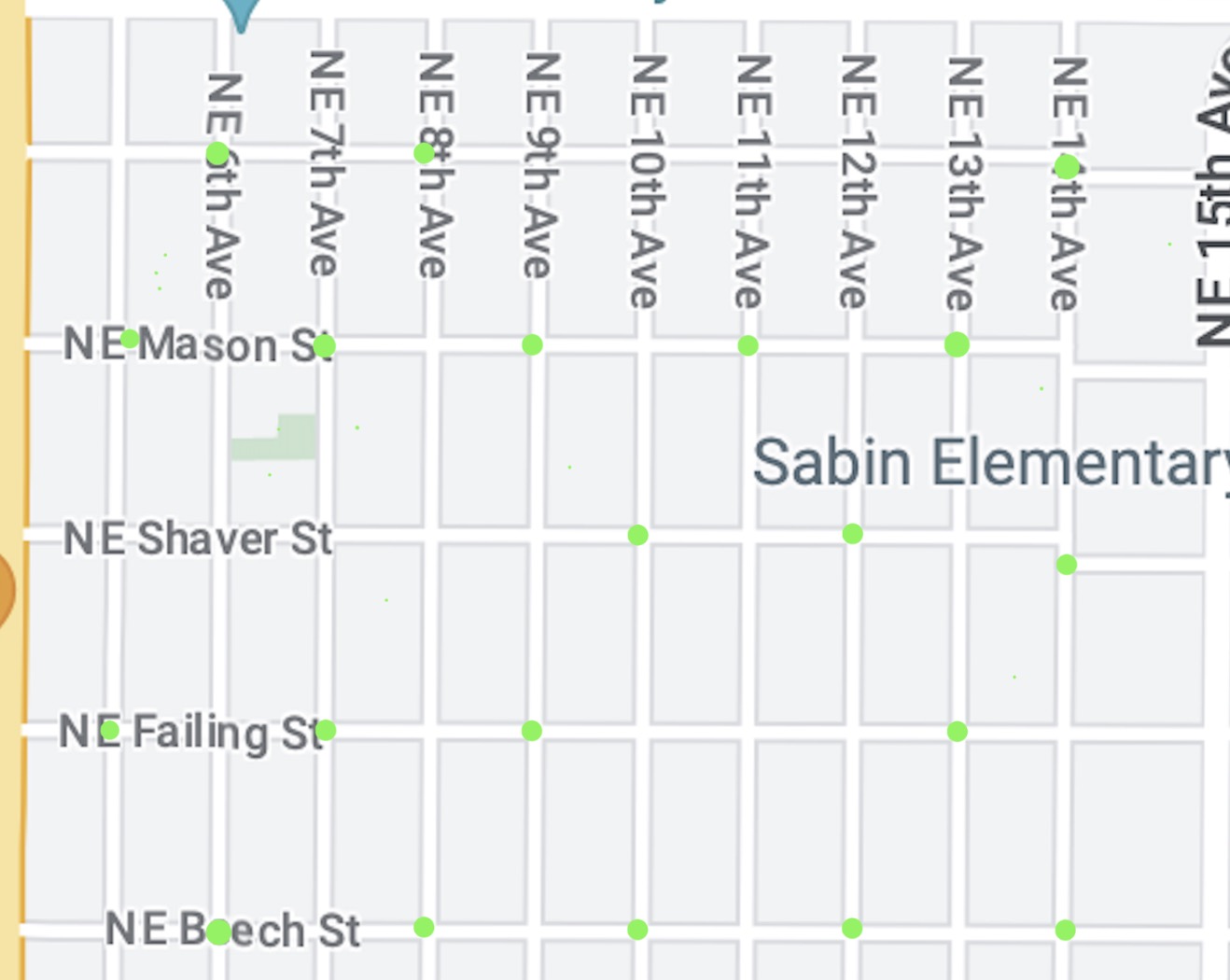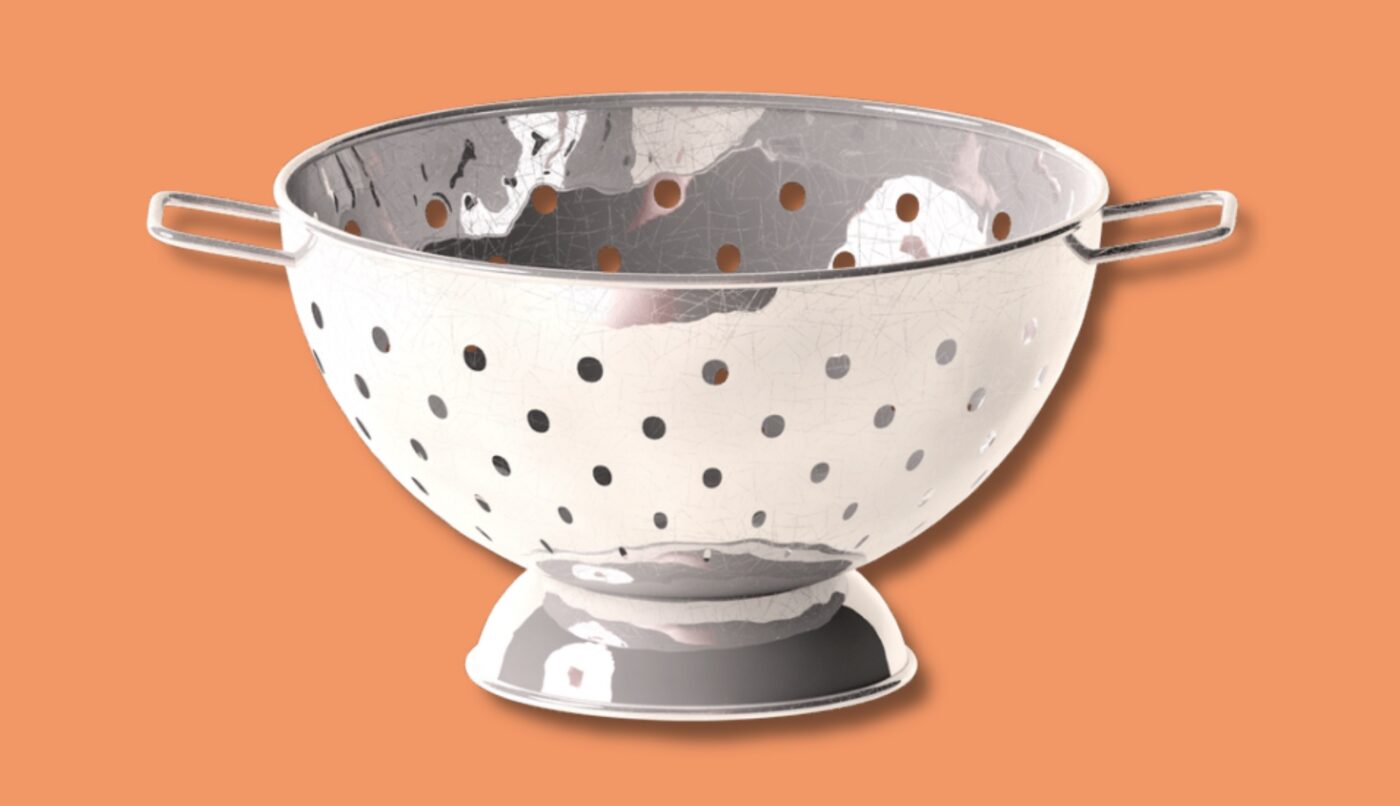 Behold the humble, transformational, neighborhood traffic “passoire,” which would allow almost anything but cars to pass through. (Graphic: Stone Doggett)
Behold the humble, transformational, neighborhood traffic “passoire,” which would allow almost anything but cars to pass through. (Graphic: Stone Doggett)
— This essay was written for BikePortland by reader and longtime family biker, runner and walker.
“A passoire, a strainer, a means of filtering out the undesirable chunks (cars) and allowing the most flavorful vital elements to pass.”
Hey Portland, it’s time to sac up, à la Française.
That opening line probably has everyone famished and ready to manger their favorite “petit dejeuner en sac.” Lick your lips, but hold the fromage, and instead let’s sink our mind-teeth into the magnificent cul de sac.
The scrumptious cul de sac has long been a delicacy for the wealthy that is mostly enjoyed in out-of-the-way suburbs and exurbs, far away from the urban poor. After a long day moving cars around, the fortunate retire to the peace and quiet of streets designed to limit noisy, threatening, outsider’s cars from rudely interrupting their repose. Day and night the cul de sac works tirelessly like a powerful missile defense system deflecting dangerous through traffic. Tragically, the beneficiaries of this modern miracle long ago declared “Sacs pour moi, not for toi!”
While the wealthy have enjoyed safe, idyllic places for their children and pets to roam free from blunt force trauma, urban areas have been slashed and scarred with highways and parking lots. Much like excessive plastic surgery gone awry, “urban renewal” changed urban residential areas into eerie resemblances of neighborhoods. Places once built for people became places built for automobiles – uncanny valleys of human habitat with highways running through the middle. Sacre bleu!
Courage, my dear Portland, we can rise from the ashes of the asphalt sins-of-our-fathers. The humble cul de sac holds the key to healing decades of self-destructive overindulgence. But honestly, we are pretty bad off, we need more than cul de sacs we need an urban super sac. We must combine the French austerity of the cul de sac with the US love of “freedom.” Freedom sacs!!! – unleashing the freedom of movement in the city. The freedom sac is in essence, a passoire, a strainer, a means of filtering out the undesirable chunks (cars) and allowing the most flavorful, vital elements to pass, like a fine consommé. Of course, if there are only one or two, the chunks roll around the sides, but a network of well-placed passoire would revolutionize transportation and enliven the urban environment with human movement.
The passoire is simple (see image above). Imagine the intersection by your house or apartment, remove the pavement from corner to corner creating a square of green space, imagine a few large trees, include the sidewalks (if you have sidewalks) and install crossing paths that are big enough for two generous-sized tricycles to pass each other on a warm summer night and blow kisses. Voilà.
“Bisou bisou Ms. Tricycle… Bisou bisou Mx. Scooter… Bisou bisou Mr. Mobility Assistance Device…”
 Green dots would be intersection filters. (Graphic: Stone Doggett)
Green dots would be intersection filters. (Graphic: Stone Doggett)
Now, look at a map of your neighborhood and pick all of the intersections that can be transformed. I picked a neighborhood with 50 intersections as an example (see image above). At a quick glance, 20 of the intersections can be liberated to create a design where each house has one route in and out of the neighborhood with a car and a multitude of paths are open and activated for less harmful vehicles.
The passoire filters out the autos that produce CO2, pollution and toxic particulates, while the trees in the passoire do their small part to consume CO2, create shade, and give life and inspiration. Peel away the hard undesirable covering and watch speeding through-traffic disappear while human movement and vitality blooms. Instead of a looking down a street to see a long line of parked cars, boats, pods, dumpsters, etc., there is an intersection 200 feet from your house with a canopy of mature trees, a bench or a barbeque with people passing through, carefree and carfree.
Brave Portland, I know this is a big step. You may be thinking, “this sounds nice, but wouldn’t it be just as good to paint something and put out a clever yard sign?” The answer is clearly “No, years of hard work by PBOT has proven that paint, yard signs and other invisible ‘safe-streets’ incantations are embarrassing gestures that our children will roll their eyes at as they face the brutality of climate devastation.” Understandably, when we gaze into the eyes of destiny, we may wonder “Do I deserve to live in a beautiful world?” The answer may surprise you, “Yes, you and every other human deserve to have a deep and fulfilling connection to the natural world.”
Threading needles, three-dimensional chess moves, and incremental changes to our carbon intensive, wasteful transportation system may have seemed like a “Portland nice” jiu-jitsu that would protect politicians and solve the transportation puzzle, but while Portland has wasted precious time and momentum, other cities have leapt forward, realizing Portland’s dreams.
To understand why miles of painted bike lanes, flashing lights and crosswalks in a city full of people who love to bike and walk has floundered, we may need to consider the tortured experience of the driver rather than the active transportation joie de vivre.
Driving hurts our monkey brain. When I am strapped down and hurled through space in a cushioned metal box, I am simultaneously bored to death and stressed out. I am subconsciously (and sometimes consciously) jarred by potential life-threatening mistakes that could end or derail my existence while I daydream, distract myself with stale music and not look at my Instagram. I am surrounded by so many other greedy monkey brains trying to feel alive in their boxes, mashing buttons and pedals too hard or too soft. For most of us, the fleeting thrill of winning the driving game often sours into rage, frustration or fatigue. Je suis fatigue!
Rationally, I can wipe it all away. But, when I see a bike lane that I can’t zip through, a space that I can’t park in or worst of all, a diverter forcing me to turn even though I can see the other side, it’s like seeing a banana in a bell jar. What sadist put this banana just out of reach? If the Portland Banana o Thieves hint at changing a traffic pattern or I see another plastic wand in my way, it doesn’t matter how many thousands of bananas I just ate, I am starving again and my monkey brain is bent.
Arrrrrrggghhhh! So many stolen bananas and in return I am only given abstract ideas about safety and happy people that do not fill this banana-shaped hole. If you take my banana, give me something in return that I can touch, something for me, something that I can fight for, make me feel rich and exclusive with a quiet street and little parklet, don’t hold back — give me a cul de sac!
Whether it is called a cul de sac, freedom sacs or a passoire, depaving intersections is both banana manna for our monkey brains and also deeply satisfying for our rational minds:
The Urban Forest: Portland’s urban forest is declining and many parking strips and available spaces are not sufficient for new large trees. Heat islands due to too much asphalt and not enough shade are straight up killing people. Dense urban housing is a highly sustainable, efficient and healthy way to build human habitat, but increasing housing density may compete with space for trees on private property and visual green space in general. The passoire would provide more green space for more people in a way that is broadly and fairly distributed.
Storm Water Drainage: Perhaps underappreciated, but a huge deal. Portland needs more permeable surfaces to absorb water. The passoire is what the bioswale aspires to be.
Community: A comfortable place to sit, wait, meet other people in public, light gardening and positive expression, a productive outlet for neighborhood associations, a game of cornhole. Neighbors can be outside of their house, but not feel out of place. The passoire is a way for every neighbor to connect with their street. Neighbors of all abilities can contribute to the beautification and place-making of passoires, unlike hardscape infrastructure that requires heavy machinery and dangerous materials.
Transportation: The brilliance of the passoire will shine brightest in how it transforms transportation. Primarily, the broad implementation of passoires will expand safety to all users,creating a safety paradigm shift within residential areas. Passoires will nearly eliminate anonymous traffic that is indifferent to the people who live on those streets, because the drivers will be close neighbors. All residential streets will become local streets. The straight-away distances of each street will be reduced to a maximum of three or four blocks, which will limit the ability of drivers to speed. By restricting travel to people going to the houses on those streets, traffic will be more predictable and will be more fairly distributed throughout residential areas.
The net result of slower, more careful drivers will unlock a safer world where pets, children and people with limited mobility can move freely. In some instances, it may actually become safe enough to “play in the street,” like children have done as long as there have been streets and still do in affluent neighborhoods. Safer, lighter modes of travel will be able to move out of the gutters as they become an even more perfect tool to navigate the city. Passoires will make every residential street a greenway. When someone heads out on a scooter, skateboard or bicycle, they can do it without a 30-minute route-planning session, consulting apps, maps and various deities in hopes that they will safely make it to their destination. They can enjoy the carte blanche that has been the exclusive privilege of car consumers, instead of the carte-spectacle de merde. The basic pathway design of each passoire can essentially be the same, without over complicated design shenanigans that take five improvisational attempts to understand. With the growing accessibility of e-bikes and e-scooters, the vast majority of trips in Portland will be safe and under 20 minutes without having to drag around and park a two-ton metal sack.
Dear Portland, the world has looked to you in the past to be that one creative but reasonable city in America. Cities in the US have looked to Portland to have enough critical mass of environmental and progressive values to shake off the yoke of a destructive, mindless, consumption-oriented existence. Activate the wasted space of redundant intersections and Sac up! Make this bold move and revolutionize how the world lives. Vive le Sac!
Thanks to reader Stone Doggett for sharing this essay. We are always looking for guest writers. If you’ve got something to share, get in touch with me via This email address is being protected from spambots. You need JavaScript enabled to view it..



